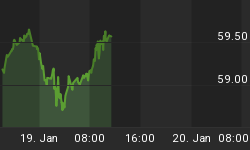The first quarter of 2018 saw the U.S. economy grow faster than expected, even though GDP was lower than the previous quarter, but what should have most worried is debt—and the fact that foreign investors aren’t as interested in buying it anymore.
The U.S. Department of Commerce data shows that GDP, or the total value of goods and services produced in the U.S.—increased at an annualized rate of 2.3 percent, down from 2.9 percent in Q4 2018 but higher than some forecasts, including Bloomberg’s, which projected GDP growth at 2 percent.
Consumer spending slowed from 4-percent growth in the fourth quarter of last year, to 1.1 percent in the first quarter of 2018. This drop in consumer spending came in spite of an increase in disposable income because of the new tax law by 3.4 percent.
Trump’s target for GDP growth is 3 percent.
In the meantime, there are growing concerns about the U.S. debt pile-up—and what appears to be a growing lack of interest among foreign investors to buy up U.S. debt, according to the Wall Street Journal.
This, WSJ says, could push bond yields higher and slow economic growth.
U.S. national debt has blasted past $21 trillion—up 2.8 percent since 1 January 2018.
While some are concerned, Moody’s, the credit ratings agency, isn’t, according a stable outlook for the U.S. last week, citing “exceptional economic strength, the very high strength of its institutions and its very low exposure to credit-related shocks given the unique and central roles of the US dollar and US Treasury bond market in the global financial system”. Related: Nasdaq Volatility Still High Ahead Of Apple Earnings Report
These strength, Moody’s said, “remove all but the most extreme liquidity risks from the US government securities market, despite a rising debt burden, and grant the US effective immunity from government liquidity and balance-of-payment risks”.
The first week in April, WSJ reported that foreigners were “bulking up” on U.S. bonds again, but as the month comes to a close, worries have been renewed.
It depends, though, on what your hedging position is. As quoted by Bloomberg, Japan’s Fukoku Mutual Life Insurance executive officer Takehiko Watabe, said they’ve shifted to unhedged foreign bonds.
“The rise in hedge costs is eroding profitability from hedged foreign bond investments, as U.S. monetary tightening boosts short-term rates. We can afford to take currency risks given our solid capital buffer and high solvency margin ration, and can focus on profitability rather than just seeking to minimize hedging costs,” Bloomberg quoted Watabe as saying.
Last week, DoubleLine Capital CEO Jeffrey Gundlach said that U.S. Treasuries were no long attractive, despite the fact that the 10-year yield had cross the 3-percent threshold.
Gundlach said the uptrend in yields would continue as foreigners would not be in favor of purchasing U.S. bonds because of hedging costs, Reuters reported.
Instead, Gundlach pointed to gold, which he said was “maintaining an upward pattern above its rising 200-day average, which is extremely good.” He also said that charts were signaling a move of $1,000 in gold prices.
By Tom Kool for Safehaven.com
More Top Reads From Safehaven.com:

















